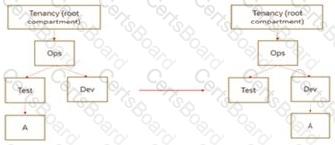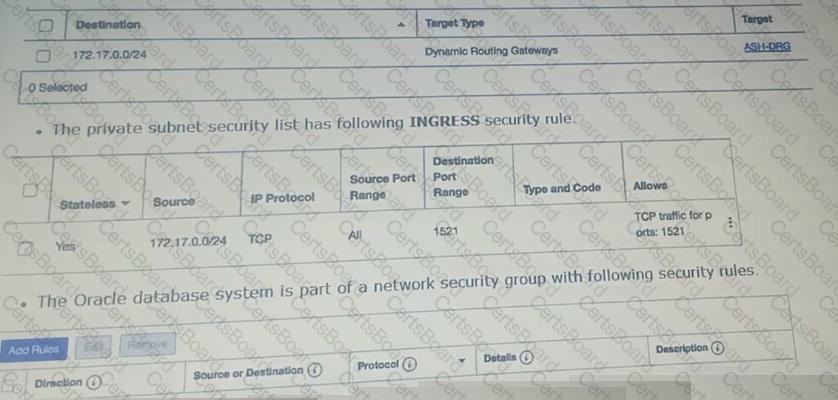Your customer has gone through a recent reorganization. As part of this change, they are organizing their Oracle Cloud Infrastructure (OCI) compartment structure to align with the company's new organizational structure. (Refer to the exhibit)

They have made the following change:
Compartment A is moved, and its new parent compartment is compartment Dev.
Policy defined in compartment A: Allow group G1 to manage instance-family in compartment A
Policy defined in root compartment: Allow group admins to manage instance-family in compartment Ops: Test: A
After the compartment move, which action will provide users of group G1 and admins with similar privileges as before the move?
You work for a German company as the Lead Oracle Cloud Infrastructure architect. You have designed a highly scalable architecture for your company's business critical application which uses the Load Balancer service auto which uses the Load Balancer service, autoscaling configuration for the application servers and a 2 Node VM Oracle RAC database. During the peak utilization period of the- application yon notice that the application is running slow and customers are complaining. This is resulting in support tickets being created for API timeouts and negative sentiment from the customer base.
What are two possible reasons for this application slowness?
After performing maintenance on an Oracle Linux compute instance the system is returned to a running state You attempt to connect using SSH t to do so. You decide to create an instance console connection to troubleshoot the issue.
Which three tasks would enable you to connect to the console connection and begin troubleshooting?
You are the security architect for a medium sized e-commerce company that runs all of their applications in Oracle Cloud Infrastructure (OCI). Currently, there are 14 unique applications, each deployed and secured in their own compartment. The Operations team has procured a new monitoring tool that will be deployed throughout the OCI ecosystem. Their requirement is to deploy one management node into each compartment.
Currently, the Operations team Identity and Access Management (IAM) group has the following policy: allow group OpsTeam to READ all-resources in tenancy
Once the new monitoring nodes are deployed, the Operations team may need to stop, start, or reboot them occasionally.
What is the most efficient solution to allow the Operations team to fully manage the monitoring nodes, without allowing them to alter other resources across the tenancy?
Your organization needs to migrate legacy monolithic applications into cloud-native containerized RESTful microservices. The development team is testing the use of packaged procedures with containers in a fully serverless environment. Before migrating the existing code to production, the team decides to perform a lift and shift of the monolithic application and code the new features that are essential for serverless microservices.
You want to carry out a steady migration to the Oracle Cloud Infrastructure (OCI) platform, making the new microservice functionalities available while maintaining the monolithic application for all the other activities. You also want to integrate the legacy monolithic application with the new microservices to have a single interface with simplified management for auditing and monitoring while meeting operational and compliance requirements.
How can you meet this requirement?
You are creating an Oracle Cloud Infrastructure Dynamic Group. To determine the members of this group you are defining a set of matching rules.
Which of the following are the supported variables to define conditions in the matching rules? (Choose Two)
You are working as a solution architect for a customer in Frankfurt, which uses multiple compute instance VMs spread among three Availability Domains in the Oracle Cloud Infrastructure (OCI) eu-frankfurt-1 region. The compute instances do not have public IP addresses and are running in private subnets inside a Virtual Cloud Network (VCN). You have set up OCI Autoscaling feature for the compute instances, but find out that instances cannot be auto scaled. You have enabled monitoring on the instances.
What could be wrong in this situation?
You are a solution architect working with a startup that has decided to move their workload to Oracle Cloud Infrastructure. Since their workload is small, upon architecting, you decide its sufficient to use 8 compute instances to run their workload. The company wants to use a common storage for their instances. So, you propose the idea of attaching a block volume to multiple instances to provide a common storage.
Which of the below option is NOT true for such a solution?
You have an Oracle database system in a virtual cloud network (VCN) that needs to be accessible on port 1521 from your on-premises network CIDR 172.17.0.0/24.
You have the following configuration currently.
Virtual cloud network (VCD) is associated with a Dynamic Routing Gateway (DRG), and DRG has an active IPSec connection with your on-premises data center.
Oracle database system is hosted in a private subnet
The private subnet route table has the following configuration
The private subnet route table has following configuration.

However, you are still unable to connect to the Oracle Database system.
Which action will resolve this issue?
A)
Add an EGRESS rule in network security group as following.

B)
Add a route rule in the private subnet route table as following.

C)
Add an EGRESS rule in private subnet scurity list as following.

D)
Add an EGRESS rule in private subnet security list as following.

Which of the below options for private access to services within Oracle Cloud Infrastructure (OCI) is NOT valid?


